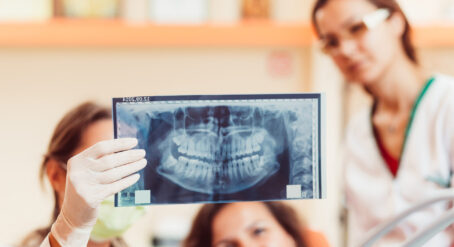You may have heard of self-ligating braces – a different orthodontic bracket that provides orthodontic treatment in much the same way as traditional metal braces. But just how do self-ligating braces work, what’s the difference between the two types, and crucially – should you consider getting them?
Here’s what you need to know about self-ligating braces.
What are the types of self-ligating braces?
There two types of self-ligating brackets:
- Active brackets use a sliding spring clip mechanism to “actively” press against the archwire, applying an active force.
- Passive brackets use a simple sliding mechanism which does not press on the archwire.
Do self-ligating braces need to be tightened?
Traditional braces require adjustments every four to ten weeks in order for them to continue applying the correct pressure to your teeth. In these appointments, your orthodontist may also replace the elastic or wire ligatures affixing your brackets to your archwires and the wires themselves may need to be replaced, adjusted, or tightened.
Self-ligating braces still need to be monitored to ensure that the clip or door in the bracket is intact and still functioning well. Patients with self-ligating brackets still require the placement of small archwire bends to straighten the teeth and/or placement of elastic ligatures to close residual space or keep unwanted spaces from opening during their orthodontic treatment. All of these procedures are still technically “tightening” the braces.
Do self-ligating braces have colours?
Because they don’t use bands like traditional metal braces, self-ligating braces don’t have the option of coming in other colours. These types of braces are metal or silver in colour because of the metal clip or door in the bracket. There are also tooth-coloured self-ligating braces available.
Are self-ligating braces faster?
Despite popular belief, self-ligating braces have not been scientifically proven to make treatment faster. Nor are there scientific claims that more effective or efficient than traditional braces. The length of your treatment will come down to your specific condition and how well you maintain your oral hygiene.
What are self-ligating ceramic braces?
This type of self-ligating braces uses a tooth-coloured or transparent bracket to keep the wire in place. Usually, your upper front teeth will have these tooth-coloured brackets while the rest of your teeth may have the traditional metal ones. This allows for a more subtle appearance when undergoing treatment. The choice of braces also depends on your orthodontist’s preferences.
Advantages of self-ligating braces
Self-litigating braces have several reported benefits, namely:
- Hygiene: One of the key benefits of a self-ligating braces is that they don’t tend to require any ligatures to secure the archwire in place. Generally made from elastic, ligatures may trap more food particles in and around the orthodontic brackets. Ligature-free braces, may in theory, catch less particles, however, they still need to be cleaned thoroughly just like any other braces to avoid problems.
- Aesthetics: Depending upon their size and design, self-ligating may be slightly less visible, a significant selling point for the self-conscious teenager (not to mention, many self-conscious adults).
- Convenience: Self-ligating braces may sometimes require fewer appointments than traditional braces, potentially offering the promise of time-saving convenience for busy patients. However, this is completely dependent upon the patient’s individual treatment requirements.
Disadvantages of self-ligating braces
Self-ligating braces are a promising new technology. But they have two key disadvantages. These include:
- Bracket issues. The sliding mechanism in self-ligating braces must be opened and closed many times during a patient’s treatment. Any moving part can give problems and may need replacement (compared to traditional brackets). It also depends on how well you treat your braces by avoiding hard and sticky foods.
- Tooth and gum problems. As with traditional braces, self-ligating braces make it harder to keep your teeth squeaky clean – though the lack of elastic bands does make access to your teeth and gums a little easier. Still, compromised brushing and flossing means trapped food particles can build up, causing tooth decay and gum disease if left untreated. Therefore, all braces, self-ligating or not, require meticulous oral hygiene to avoid dental and gum problems.
What is the cost of self-ligating braces?
While prices always vary, self-ligating braces may cost more than conventional ones – often by around $1,000.
What’s ultimately better: self-ligating or traditional braces?
Ultimately, scientific evidence shows that the type of bracket attached to your tooth (i.e. self-ligating or traditional bracket) makes little difference to your overall treatment outcomes. What makes a much greater difference is the knowledge and clinical experience of your specialist orthodontist.
Disclaimer
Self-ligating braces as a treatment method are still being tested in clinical research, however, they have not been proven to make treatments significantly faster, better or more comfortable for patients. Registered specialist orthodontists in Australia are committed to continuous research through well-controlled studies and continue to make treatment decisions based on best practice advice and patient outcomes. We recommend always consulting an orthodontist prior to commencing any form of orthodontic treatment and getting a second opinion if you’re unsure about the recommendation made to you. You can find an orthodontist in your area using our Finder Tool.











